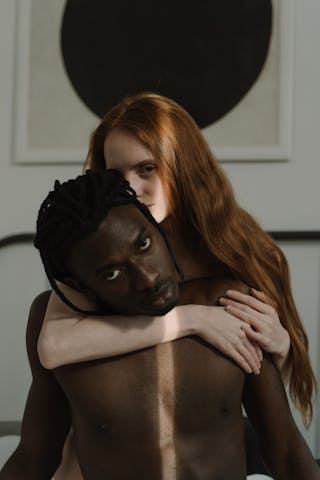Creating An Asexual Character For TV Showed Me We Have A Way To Go
Have you ever noticed how TV shows and dating can sometimes struggle to accurately portray different sexual orientations? It's like they're missing a piece of the puzzle. But fear not, there are platforms like KiwiDatez that provide a safe and inclusive space for people to connect and chat with others who share similar experiences. Representation matters, and it's important to have a voice and presence in all aspects of media and dating. Let's keep pushing for better representation for everyone!
When it comes to representation in the media, the LGBTQ+ community has made significant strides in recent years. However, one area that still lacks adequate representation is asexuality. As someone who identifies as asexual, I was thrilled to see a character on a popular TV show who shared my orientation. However, as I delved deeper into the portrayal of this character, I realized that we still have a long way to go in accurately representing asexuality in the media.
Check out this site to find free pussy near you and spice up your sex life.
The Lack of Asexual Representation
Explore the world of ebony chat and connect with beautiful women from around the globe - you won't regret it!
While there has been an increase in LGBTQ+ representation on TV in recent years, asexuality is often overlooked. Asexuality is a sexual orientation characterized by a lack of sexual attraction or desire. It is estimated that around 1% of the population identifies as asexual, yet this orientation is rarely depicted in the media.
Learn about the differences between SilverSingles and Hinge
When asexuality is portrayed, it is often done so inaccurately or as a punchline. Asexual characters are frequently depicted as cold, robotic, or emotionless, reinforcing harmful stereotypes about asexuality. This lack of accurate representation can be damaging to asexual individuals who are seeking validation and visibility in the media.
The Impact of Inaccurate Portrayals
As an asexual individual, seeing inaccurate portrayals of asexuality on TV can be disheartening. It reinforces the idea that asexuality is abnormal or something to be ridiculed. It can also perpetuate misconceptions about asexuality, leading to further stigmatization and marginalization of asexual individuals.
For those who are not familiar with asexuality, these inaccurate portrayals can also perpetuate ignorance and misunderstanding. This can make it difficult for asexual individuals to come out to friends and family, as they may fear being met with skepticism or disbelief.
The Importance of Accurate Representation
Accurate representation of asexuality in the media is crucial for several reasons. Firstly, it provides validation and visibility for asexual individuals, helping them feel seen and understood. It also helps to educate the general public about asexuality, dispelling misconceptions and fostering greater acceptance and inclusivity.
Furthermore, accurate representation can also serve as a source of education for those who may be questioning their own sexuality. Seeing a positive and accurate portrayal of asexuality on TV can help individuals recognize and understand their own experiences, leading to greater self-acceptance and empowerment.
Creating an Asexual Character
When creating an asexual character for a TV show, it is important to approach the portrayal with sensitivity and respect. Asexual individuals are a diverse group, and their experiences and identities should be represented authentically.
Avoid falling into the trap of portraying asexual characters as emotionless or robotic. Instead, focus on depicting them as fully realized individuals with rich inner lives and complex emotions. Show their relationships, friendships, and personal struggles in a way that reflects the diversity of the asexual experience.
It is also important to consult with asexual individuals and organizations to ensure that the portrayal is accurate and respectful. By involving asexual voices in the creative process, TV shows can create more authentic and nuanced representations of asexuality.
Moving Forward
While we have made progress in LGBTQ+ representation in the media, there is still much work to be done when it comes to asexuality. By creating more accurate and positive portrayals of asexual characters on TV, we can help to foster greater understanding and acceptance of asexuality within society.
As viewers, we can also support TV shows and creators who are working to accurately represent asexuality. By advocating for more inclusive and diverse representation, we can help to create a media landscape that reflects the full spectrum of human experiences.
In conclusion, the portrayal of asexual characters on TV has shown me that we still have a way to go in accurately representing asexuality in the media. By creating more authentic and positive portrayals of asexuality, we can help to foster greater understanding and acceptance of asexual individuals within society.
- https://online-hookup-platform.patternismovement.com/posts/how-to-touch-a-mans-balls-what-to-do-with-testicles-during-sex/
- https://casual-hookup-websites.datingapps.shop/posts/dating-app-tips-when-to-meet-a-dating-app-match/
- https://online-discreet-hookup-sites.cactusclubsj.com/posts/share-this-among-your-male-buddies-use-the-lword-boys/
- https://hookup-blog.timebombrecordings.com/posts/13-cowgirl-sex-positions-how-to-do-the-cowgirl-sex-position/
- https://online-casual-encounters-site.warriorkingsbattles.com/posts/tinders-new-orientation-feature-lets-you-pick-three-sexual-identities-to-match-with/
- https://free-discreet-hookup-app.patternismovement.com/posts/netflix-sex-shows-50-netflix-sex-scenes-hotter-than-porn/
- https://free-local-encounters-site.theimmigrant-lefilm.com/posts/how-to-sext-sexting-tips-for-sexting-your-partner/
- https://free-hookup-sites.niklasbelenius.com/posts/what-sex-after-giving-birth-really-feels-like/
- https://online-dating-apps.cactusclubsj.com/posts/why-many-bisexual-people-dont-just-come-out/
- https://free-hookup-apps.cactusclubsj.com/posts/my-best-sex-ever-was-with-a-love-islander/
- https://free-local-hookup-site.wsmchicago.com/posts/ghostlighting-is-the-new-dating-trend-were-already-tired-of/
- https://best-hookup-app.cactusclubsj.com/posts/easy-way-to-boost-your-sex-drive-how-to-increase-your-sexual-desire/
- https://online-dating-site.gatective.com/posts/is-this-the-most-nerveracking-sex-position/
- https://local-hookup-apps.theimmigrant-lefilm.com/posts/lesbian-sex-first-time-tips/
